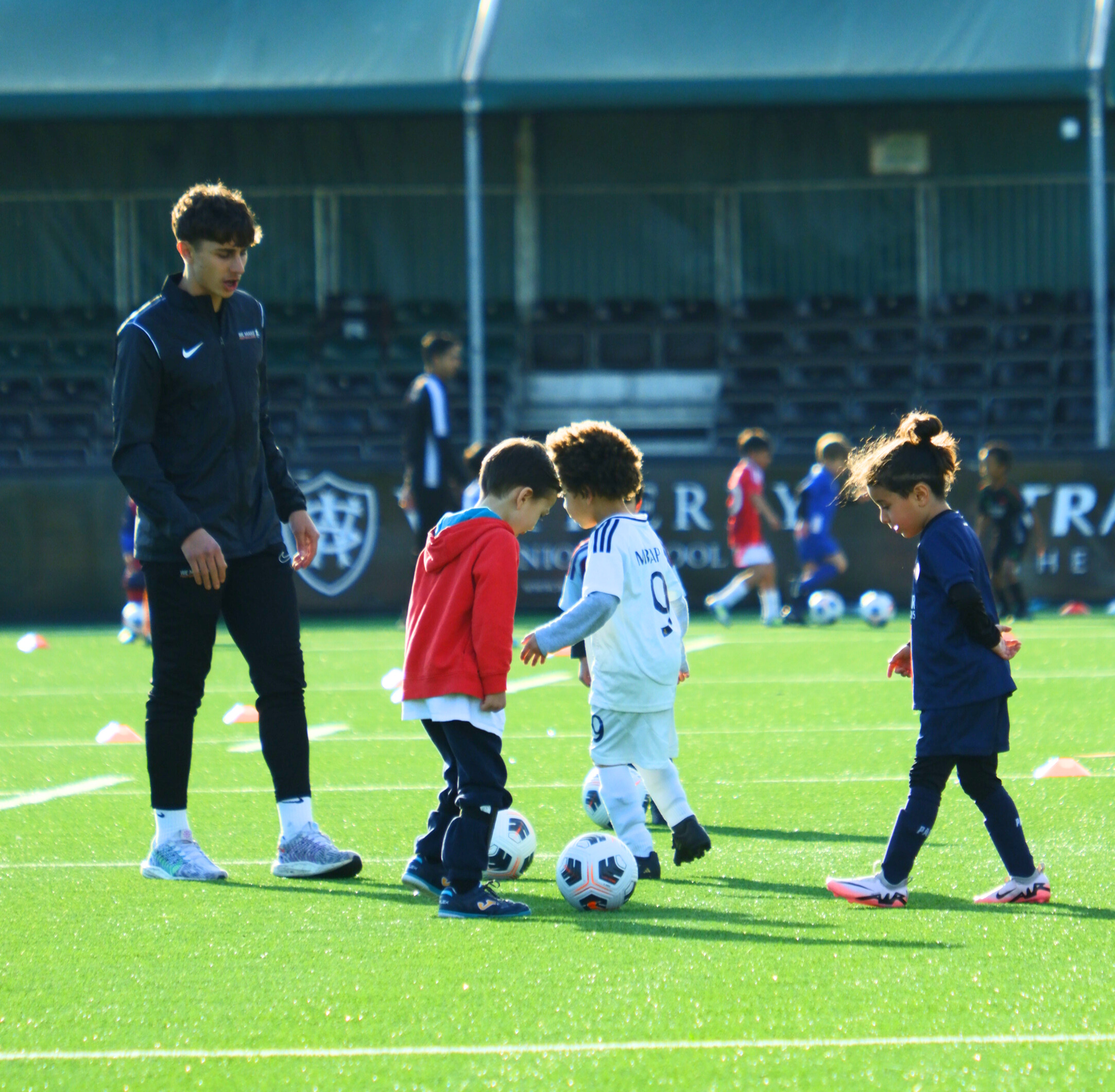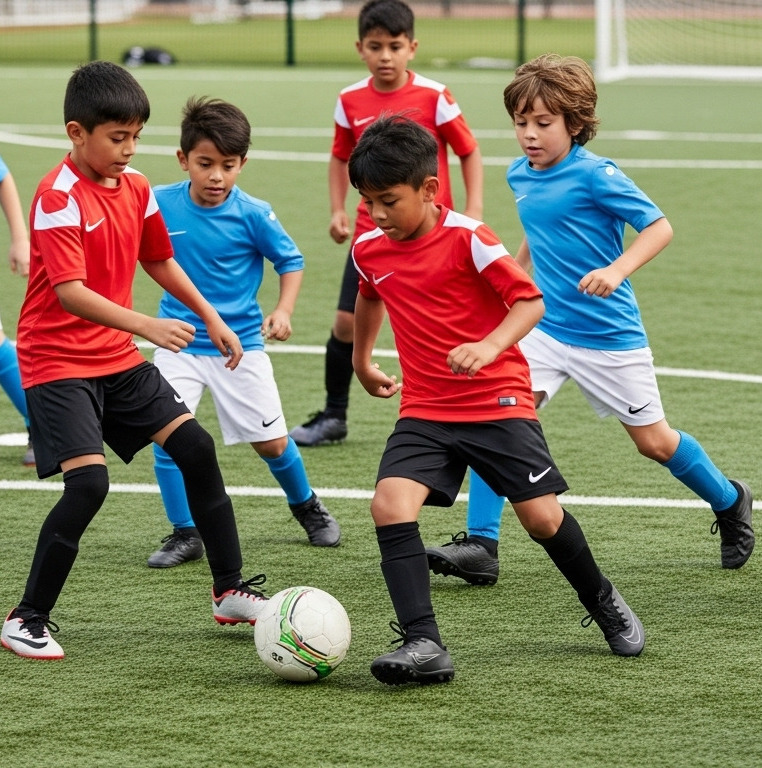How to Tackle in Football: Techniques, Rules, and Safety
Tackling is one of the key defensive foundations in football. It’s how defenders win the ball, protect their goal, and break down attacks — but when taught poorly, it’s also where the most mistakes and injuries happen. If you want to raise confident, brave, and technically smart players, teaching them how to tackle in football the right way is essential.
At We Make Footballers, we coach children aged 4–12 to tackle with purpose, precision, and care. Through structured drills and progressive sessions, players develop their awareness, footwork, timing, and ability to make a clean football tackle, all while staying safe and within the laws of the game.
What is a Tackle in Football?
A football tackle is a defensive action aimed at legally taking the ball away from an opponent. In youth football, this can be done standing up, by intercepting, or with a low, controlled slide.
But what is a tackle in football in deeper terms? It’s both a technical skill and a decision. A well-judged tackle stops an attack. A rushed one might cause a foul, miss the ball entirely, or leave your team exposed. Teaching children to read the play, be patient, and act at the right moment is just as important as the physical challenge itself.
There’s also a clear line between good tackles in football and unsafe ones. Players need to understand not only technique but also football tackle rules: what’s legal, what’s careless, and what’s dangerous.
At We Make Footballers, we build that understanding step by step, so that the tackle becomes a smart, confident choice, not just a reaction.
Types of Tackles in Football
Understanding the different types of tackling in football helps players know how to defend in all parts of the pitch whether at full-back, centre-back, midfield or even as a pressing forward.
Common Types of Football Tackle:
-
Standing Tackle. Most often used in close 1v1 situations. The defender steps across or into space to take the ball cleanly from the feet without falling or diving. Emphasises patience and balance.
-
Slide Tackle. When an attacker’s touch runs loose, or you’re chasing back, a quick low slide with one extended leg can knock the ball away. Sliding must only be used sparingly: badly timed slide tackles are among the most common football dangerous tackles seen in the game.
-
Block Tackle. This aggressive but controlled approach is used when the defender steps in to make strong, shoulder-width contact with the ball using foot pressure and body strength, often when meeting it simultaneously with the attacker.
-
Poke Tackle. Used to jab the ball cleanly away with the toe or side of the foot — often from the side or behind. The attacker may still retain partial control, so it’s often paired with fast follow-up positioning.
-
Shoulder Challenge. Legal contact between players of similar pace and position. A strong shoulder-to-shoulder collision can disturb the attacker’s balance and force mistakes, but the defender’s feet must stay on the ground and arms tucked in, in line with football tackle rules.
-
Interception/Delay as a Tactical ‘Tackle’. While not a textbook tackle physically, at We Make Footballers we teach players how to intercept the ball in motion, or delay attackers long enough for team support. This form of intelligent defending prevents danger without committing to risky contact.
Each type has its purpose and learning when not to tackle is just as much a skill as learning when to go for the ball.

Step-by-Step: How to Make a Perfect Football Tackle
Learning to make a perfect tackle in football requires more than aggression or bravery, it takes anticipation, body position, and control.
Our Step-by-Step WMF Method:
-
Approach the Opponent with Control
Don’t bolt in. Use quick, small steps to close space gradually. -
Get Your Stance Right
Knees bent, weight forward, arms down, head up. Ready to react in either direction. -
Watch the Ball, Not the Feet
Hips and waist tell you much more than fast footwork. Stay focused on the core path. -
Jab and Disrupt
When the attacker shifts their weight, steps wide, or overhits a touch - go. Use the front foot to take the ball first, not the legs or body. -
Recover Quickly
Whether you win the ball or not, never stay on the ground or turn off. Position yourself again and anticipate what comes next.
This process removes recklessness. It’s how we turn tackling into a measurable, repeatable skill, not a moment of guesswork.
Avoiding Bad Tackles in Football
Bad tackles in football aren’t always aggressive; sometimes, they come from uncertainty or hesitation.
At We Make Footballers, we correct common youth mistakes like:
-
Tackling flat-footed or from behind
-
Standing too upright or stiff
-
Charging in without reading the play
-
Leaving a leg dangling when beaten
-
Recovering by pulling shirts or blocking with arms
In our sessions, players practice recognising danger, not just reacting. A delayed or poorly-timed challenge is just as costly as a late one.
We train kids to avoid situations that lead to football dangerous tackles, starting with better spacing, angles, and restraint.
Football Tackling Techniques and Training Drills
Real defensive ability comes from repetition, coaching, and clarity. That’s where our training design stands out.
At We Make Footballers, we work on football tackling techniques from the first age group, making them fun, safe, and part of a larger picture of movement, positioning and confidence-building.
Drills We Use to Build Technique:
-
1v1 Gate Defending
Players work in pairs where attackers try to dribble through a gated space. Defenders apply pressure, delay, and choose the moment to commit, perfect for building decision-making and balance. -
Two-Touch Chase and Challenge
Attackers take two allowed touches across a grid, defenders shadow and then win back. Improves timing and teaches active patience. -
Mannequin vs. Ball-Only Slide Tackles
Slide tackles on empty passes teach form without risk. We emphasise control, width, contact zone, and safe slide technique. -
Angle Approach Transition Drill
Defenders close space from open angles, practising how to shift body weight, balance pressure, and challenge in wider zones.
These aren’t just “energy drills”. Each one includes technical coaching points, role modelling by We Make Footballers coaches, and micro-corrections in posture, distance, and recovery.
Safety and Football Tackle Rules
All our tackling training follows a primary goal: injury prevention. We use firm boundaries to create a safe playing culture.
Football Safety Checklist We Follow at Every Session:
-
Slide Only at Angle, and Never From Behind
-
No Tackles with Raised Foot or Studs
-
No Tackling from the Blind Side unless 100% clear improvement in ball control
-
No Using Arms or Hands to Gain Advantage
-
Immediate Refocus After Contact (Don’t celebrate or stop play — reset shape and engage again)
When we talk about football tackle rules, we mean more than referee laws. It's a full ethic of respect. You don’t have to tackle every time to be a great defender. You just have to tackle right when it matters.
Kids who understand how to avoid football dangerous tackles are those who move through the game safer and often with fewer fouls and more confidence.
We also help players learn how to absorb big contact moments, what many call massive football tackles, by using their core strength, positioning, and timing to “ride" the impact when necessary.
Why Tackling Shapes the Flow of the Game
Tackling solves more than just defensive problems. A good tackle:
-
Stops play before danger actually forms
-
Creates unplanned attacking chances by winning possession
-
Mentally resets the attacker and team
-
Creates trust in teammates around you
Many young players think defending is about “getting stuck in” but real defenders learn to read structure. They learn to shape the opponent’s moves, close space, and occasionally, step in at the exact moment to steal the ball clean.
That’s how we define a perfect tackle in football. Cleaner than a pass, safer than a block, and rewarding to both the individual and the team.
Ready to Help Your Child Master the Art of Tackling?
If your child constantly dives into tackles, chooses poor moments to challenge, or hasn’t been taught how to do it safely, that can be corrected quickly with expert, structured coaching.
At We Make Footballers, tackling is one of many key skills taught within our broader player development system, alongside dribbling, passing, defending, and positioning.
They will learn:
-
The different types of tackling in football, and when to use each
-
How to improve tackling in football step by step
-
Safe, confident techniques grounded in proper form
-
Why great defenders choose when to tackle not just react
-
How to defend with focus, not fear
👉 Book a trial with We Make Footballers today and see how the right tackle at the right time can change how your child plays, moves, and enjoys football.



